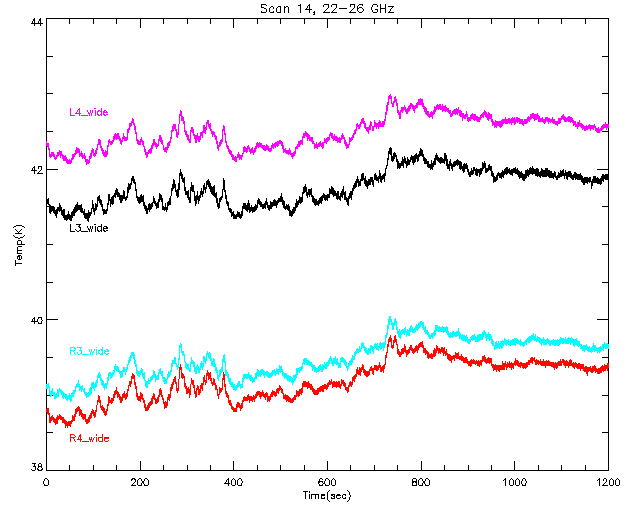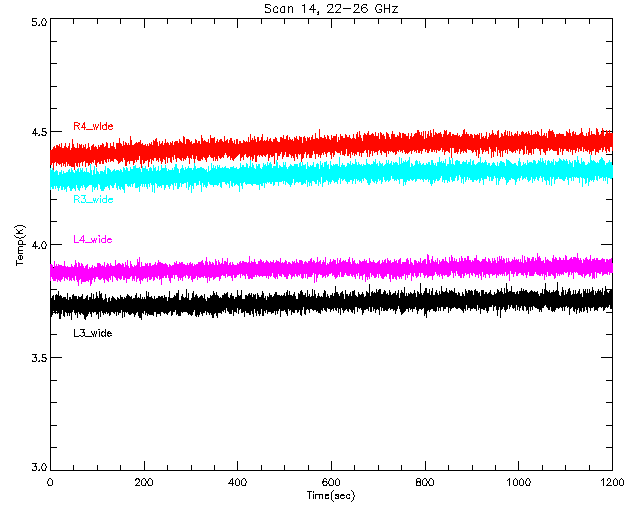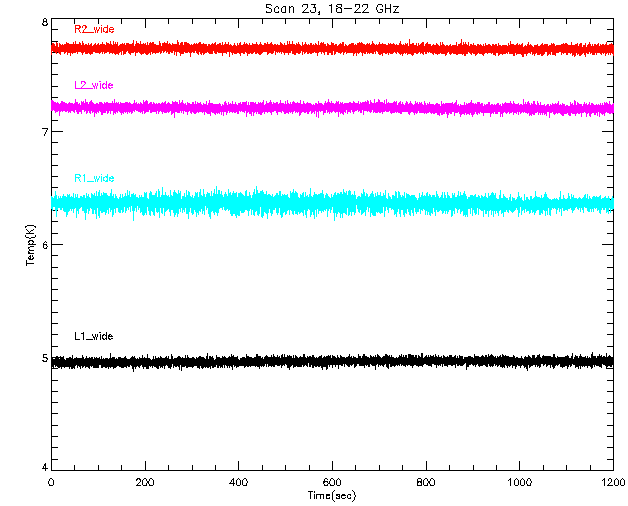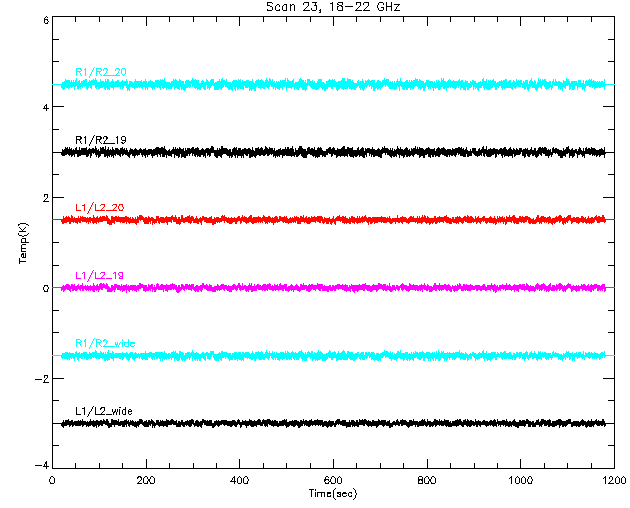
Table 1: IF Channels. The "Name" gives the labels that will identify these channels on the subsequent plots. The name is the beam designation (L1, R1, L2, R2, etc) and "_wide" for the wideband IFs from the IF Rack, or the center frequency for the 800 MHz channels. For example, "L4_25" means beam 4, left circular, 800 MHz band centered at 25 GHz.
| 18-22 GHz Receiever | 22-26 GHz Receiever | |||||||
|---|---|---|---|---|---|---|---|---|
| Name | DCR channel | Fcent|
| Name | DCR | channel Fcent | | ||
| L1_wide | 1 | 19.9 | 4200 | L3_wide | 2 | 24.2 | 4800 | |
| R1_wide | 3 | 19.9 | 4200 | R3_wide | 4 | 24.2 | 4800 | |
| L2_wide | 5 | 19.9 | 4200 | L4_wide | 6 | 24.2 | 4800 | |
| R2_wide | 7 | 19.9 | 4200 | R4_wide | 8 | 24.2 | 4800 | |
| L1_19 | 9 | 19.0 | 800 | L4_24 | 9 | 24.0 | 800 | |
| L1_20 | 10 | 20.0 | 800 | L4_25 | 10 | 25.0 | 800 | |
| L2_19 | 11 | 19.0 | 800 | L3_24 | 11 | 24.0 | 800 | |
| L2_20 | 12 | 20.0 | 800 | L3_25 | 12 | 25.0 | 800 | |
| R1_19 | 13 | 19.0 | 800 | R4_24 | 13 | 24.0 | 800 | |
| R1_20 | 14 | 20.0 | 800 | R4_25 | 14 | 25.0 | 800 | |
| R2_19 | 15 | 19.0 | 800 | R3_24 | 15 | 24.0 | 800 | |
| R2_20 | 16 | 20.0 | 800 | R3_25 | 16 | 25.0 | 800 | |
Figure 1. Wide-band channels, 22-26 GHz

800 MHz channels, 22-26 GHz
Spectra have been shifted arbitrary amounts in Y, for clarity.
These are pretty much the same as the wide-band channels, but
the Y scale is different.
Figure 2. 800MHz channels, 22-26 GHz

Figure 3. Wide-band channels, 18-22 GHz

Figure 4. 800 MHz channels, 18-22 GHz

Again, spectra have been arbitrarily shifted in Y.
One may note a systematic drift in some channels over the 30 minute observaion.
Figure 5. Gain Fluctuations: 22-26 GHz (wideband)

The drift in the gain is characterized by taking the difference between an average of points at the beginning of the scan and at the end, then dividing by the average over the whole scan. This is shown in the "Drift" column in Table 2. The gain rms values ("Grms") are the rms over the scan after removing a 2nd order polynomial fit to the data. We would expect the rms noise to be about a factor of two lower for the 4 GHz bandwidth channel, but it isn't. As one can see from the table, the wideband channels have rms of about 16-20 milliKelvins for the 0.1 sec sample time, and the 800 MHz channels are about 30 mK.
The results for longer integration times were found by averaging the raw data over 1, 10, and 100 seconds and doing the same analysis that was done for the 0.1 sec data. The results are shown in Table 2. Similar operations were done for the low band receiver (18-22 GHz) and those results are shown below in Table 3.
One may compare these results with those from the January 8 data, we find the rms gain fluctuations much smaller, but still considerably larger than the prediction of the radiometer equation. The radiometer equation predictions are listed at the end of the table.
Table 2. Results for 22-26 GHz (scan #14).
Channel TCal Tsys Drift ----------Grms(mK)---------------
K K % (0.1 s) (1.0 s) (10 s) (100 s)
L3_wide 3.74 41.76 0.630 18.85 5.72 2.71 1.91
R3_wide 4.31 39.49 0.994 19.61 5.66 2.22 1.16
L4_wide 3.89 42.49 0.706 16.49 4.93 2.16 1.48
R4_wide 4.43 39.19 1.409 19.48 5.68 2.36 1.45
L4_24 3.45 40.81 0.724 27.24 8.83 3.37 1.71
L4_25 3.44 39.04 0.699 24.18 8.40 5.21 4.45
L3_24 3.48 41.04 0.460 27.95 8.63 3.71 2.06
L3_25 3.09 34.85 0.292 23.05 7.33 2.83 1.32
R4_24 4.72 38.99 1.135 30.61 9.12 3.55 1.54
R4_25 4.38 37.04 -0.371 26.34 8.11 3.17 1.18
R3_24 4.39 44.08 0.701 29.81 9.01 3.76 2.37
R3_25 4.02 34.89 0.482 23.16 7.27 3.05 1.68
Predicted (bw=4800 MHz; Tsys=40) 1.7 0.5 0.2 0.05
Predicted (bw=800 MHz; Tsys=40) 4.1 1.3 0.4 0.13
|
Figure 6. Gain Fluctuations: 18-22 GHz (wideband)

Table 3. Results for 18-22 GHz (scan #23).
Channel TCal Tsys Drift ----------Grms(mK)---------------
K K % (0.1 s) (1.0 s) (10 s) (100 s)
L1_wide 5.16 35.93 0.261 20.46 6.11 2.60 1.30
R1_wide 5.37 37.94 -0.182 35.94 10.54 3.78 1.69
L2_wide 5.21 35.74 -0.275 21.28 6.95 3.89 2.97
R2_wide 4.73 39.05 -0.123 20.20 5.98 2.54 1.67
L1_19 4.61 32.01 -0.362 19.67 6.24 2.71 1.77
L1_20 5.89 32.30 0.063 20.67 7.41 4.36 3.19
L2_19 4.64 32.22 -0.673 20.63 6.48 3.04 2.13
L2_20 5.92 32.25 -0.647 21.76 7.57 4.57 3.32
R1_19 6.62 38.65 -0.762 35.87 10.79 4.22 1.79
R1_20 5.36 38.47 -1.015 37.32 11.12 4.40 2.11
R2_19 5.86 26.13 0.249 20.95 7.10 3.85 2.61
R2_20 3.17 24.37 0.536 19.54 6.01 2.57 1.35
Predicted (bw=4200 MHz; Tsys=40) 1.8 0.4 0.2 0.06
Predicted (bw=800 MHz; Tsys=40) 4.1 1.3 0.4 0.13
|
Figure 7. Beam Ratios: 18-22 GHz

To remove these long-term drifts, we median-filtered the data and subtracted from the original, then deleted outliers beyond 3 sigma. (The median filter window was 1/30 of the scan duration). The result is a scan with flat baselines. The next plot shows these flattened scans. Arbitrary offsets have been added in Y so the plots are not all on top of each other.
Figure 8. Flattened Beam Ratios: 18-22 GHz

This table shows the RMS in each channel after dividing and flattening. The RMS is show for three cases integrating over 0.1, 1.0, and 10 seconds and doing the same processing after doing the integrating in each case.
|
Table 4. RMS for beam ratios, 18-22 GHz.
Channel --------Trms(mK)-------------
(0.1 s) (1.0 s) (10 s)
L1/L2(wide) 30.46 19.67 9.20
R1/R2(wide) 36.74 22.67 10.07
L1/L2(19) 31.41 20.54 11.27
L1/L2(20) 32.45 21.09 10.05
R1/R2(19) 42.27 26.14 11.85
R1/R2(20) 44.57 28.23 13.74
|
For 22-26 GHz band, divide beam 3 data by beam 4, then calculate the rms over after removing drift by a median filter, and removing outliers.
|
Table 5. RMS beam ratios, 22-26 GHz.
Channel --------Trms(mK)-------------
(0.1 s) (1.0 s) (10 s)
L3/L4(wide) 27.22 18.93 9.25
R3/R4(wide) 26.60 16.90 9.67
L3/L4(24) 32.53 21.14 10.61
L3/L4(25) 26.70 17.55 9.20
R3/R4(24) 36.32 21.06 10.56
R3/R4(25) 27.64 16.16 8.94
|
Figure 9. RMS vs Integration time: 18-22 GHz
